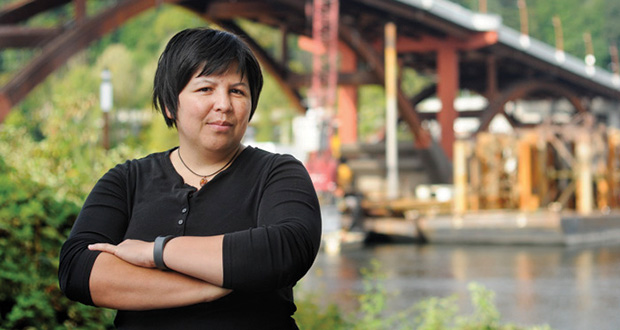Film spotlights a tradeswoman’s challenges
By: Bridgetower Media Newswires//November 23, 2016//

Stephanie Basalyga
BridgeTower Media Newswires
Dawn Jones Redstone may have traded a hammer for a video camera, but her connection with the construction industry didn’t end with the transition from journeyman carpenter to videographer and filmmaker.
Since starting her Portland, Ore.-based company, Hearts and Sparks Productions, Redstone has built a solid reputation producing what she describes as “community-minded,” documentary-style videos. Recently, she released her first short feature film, which was recently shown as part of the 2016 Portland Film Festival.
The 20-minute film, “Sista in the Brotherhood,” tells the fictional story of Laniece, a young black woman who is a finishing an apprenticeship as a carpenter on a project in Portland. With just a few hours left before she “journeys out,” Laniece finds herself battling race and gender discrimination, and must make a decision whether to stand up for what is right or stay quiet to earn her journeyman designation.
The original inspiration for the film came from a work by Roberta Hunte, a professor of black and gender studies at Portland State University, who also teaches courses in diversity and inclusion.
Hunte, who Redstone met when both women were working at Oregon Tradeswomen, had written a dissertation that she later turned into a stage play. “My Walk Has Never Been Easy” featured characters talking about the challenges and successes they had encountered as women of color working in the construction trades.
Redstone was watching a performance of the play in Portland when she began to turn over the idea of using it as the basis for a short film. Her focus on visual storytelling, up to that point, had been mostly social-justice-focused documentaries and projects for clients. While working in construction she had taken some video and filmmaking classes. Using that experience as a foundation, she began to build her skills in visual storytelling.
After leaving her job with a construction company, she spent nine years teaching construction with Oregon Tradeswomen and producing about 20 videos for the nonprofit, which helps women enter careers in the construction trades.

“I’m drawn to documentaries, but I sometimes feel with documentaries we’re talking to ourselves,” Redstone said. “People who go to see (documentaries) are already drawn to the subject matter.”
For a story about the challenges that tradeswomen face in the industry, Redstone felt a different treatment was needed.
She also realized that simply taking one character’s story from Hunte’s play wasn’t the best approach. Instead, she joined forces with Kjerstin Johnson, a Portland-based writer and editor who already had one screenplay to her credit, to come up with an original storyline that, while fictional, also contains elements of nonfiction.
“I definitely incorporated some of my own experiences,” Redstone said. “It is inspired by true stories.”
“Sista in the Brotherhood” has made a strong connection with tradeswomen, who say they experience on a daily basis many of the challenges that Redstone’s main character faces in the film.
One pivotal scene, for example, features the main character taking refuge in a portable bathroom on the job site, talking to herself as she tries to determine whether to stand up for herself or stay quiet and keep her job.
“Any tradeswoman (who’s been on a job site) knows that’s the only place you can go to have a place to yourself — to just be alone or even to cry,” Redstone said.
Redstone is quick to point out that her purpose for making the film wasn’t to bash the construction industry. But it was important to her to point out that just attracting women to careers in construction — a big push is under way in the industry — isn’t enough.
“There’s more attention (now) to women in the trades, probably out of necessity,” she said. “But there isn’t necessarily enough talk about what happens after they get there. We may be getting more women in the (trades), but how do we retain them?”
Redstone hopes the film, which is racking up an impressive list of awards, not only highlights that dilemma but also leads people — both those in the industry and those outside — to experience a new empathy for what minority women in the trades face. The reception so far indicates that she’s succeeding in those goals.
“It’s about the human condition, someone who is pushed to her own end and has to figure out how to deal with it,” said Redstone, who is Latina. “I want to give (the audience) a chance to see what it’s like through the eyes of a woman of color.”
Legal News
- Former law enforcement praise state’s response brief in Steven Avery case
- Eric Toney announces re-election bid for Fond du Lac County District Attorney
- Former Wisconsin Democratic Rep. Peter Barca announces new bid for Congress
- Republicans file lawsuit challenging Evers’s partial vetoes to literacy bill
- More human remains believed those of missing woman wash up on Milwaukee Co. beach
- Vice President Harris returning to Wisconsin for third visit this year
- Wisconsin joins Feds, dozens of states to hold airlines accountable for bad behavior
- Trump ahead of Biden in new Marquette poll
- Bankruptcy court approves Milwaukee Marriott Downtown ‘business as usual’ motion
- New Crime Gun Intelligence Center to launch in Chicago
- Arrest warrant proposed for Minocqua Brewing owner who filed Lawsuit against Town of Minocqua
- Wisconsin Supreme Court justices question how much power Legislature should have
WLJ People
- Power 30 Personal Injury Attorneys – Russell Nicolet
- Power 30 Personal Injury Attorneys – Benjamin Nicolet
- Power 30 Personal Injury Attorneys – Dustin T. Woehl
- Power 30 Personal Injury Attorneys – Katherine Metzger
- Power 30 Personal Injury Attorneys – Joseph Ryan
- Power 30 Personal Injury Attorneys – James M. Ryan
- Power 30 Personal Injury Attorneys – Dana Wachs
- Power 30 Personal Injury Attorneys – Mark L. Thomsen
- Power 30 Personal Injury Attorneys – Matthew Lein
- Power 30 Personal Injury Attorneys – Jeffrey A. Pitman
- Power 30 Personal Injury Attorneys – William Pemberton
- Power 30 Personal Injury Attorneys – Howard S. Sicula








